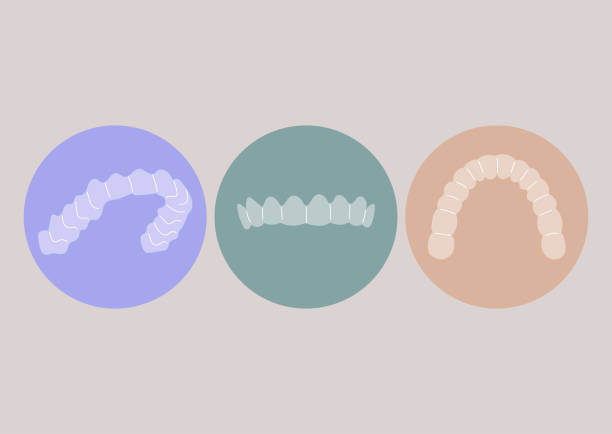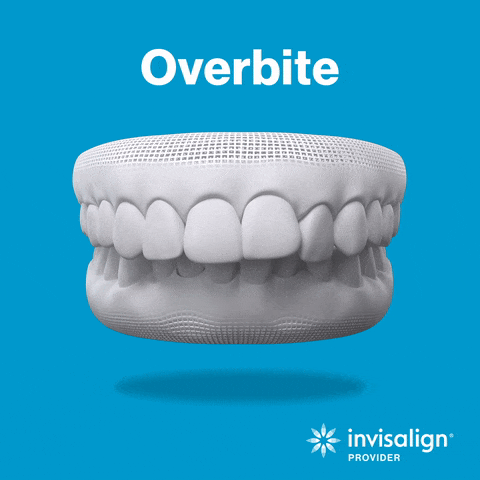Overbites are a common condition that accounts for almost 70 percent of all dental issues. One of the most common questions we get is, “Can you fix an overbite with Invisalign?” Luckily, the answer is yes! While there are a variety of ways to treat an overbite, clear aligners is one that may surprise you. Invisalign is a relatively new treatment option (compared to braces), and many people are curious know more about how it works.

Invisalign can treat an overbite by gradually shifting the teeth into their proper position. The alignment of teeth is just one aspect of treating an overbite. Your dentist or orthodontist will determine whether you are a good candidate for Invisalign or if another treatment option is more appropriate for your needs.
An overbite is a kind of malocclusion or improper bite. It occurs when the top row of teeth juts out over the bottom row. In a normal bite, the upper front teeth overlap the lower front teeth slightly, and the back molars match up in a vertical line. In an overbite, that vertical alignment between upper and lower molars is lost. The back of the bottom row of teeth can be seen behind the upper front teeth.
Overbites can be caused by genetics, or they can develop due to childhood oral habits like thumb sucking or tongue thrusting. Braces or other orthodontic treatments like clear aligners can usually correct them.
Both Invisalign and traditional metal braces are both effective at treating overbites. Invisalign uses a series of removable trays to straighten teeth over time. For overbites, the Invisalign device will work to rotate the upper teeth backward and the lower teeth forward so that they sit on top of each other appropriately. The series of aligners must be worn for 20 to 22 hours per day for the treatment to be successful. Invisalign treatment typically lasts one year but can last longer depending on how severe the problem is.
Traditional metal braces are typically used when more extensive orthodontic work is needed. They are more invasive than Invisalign trays, and treatment typically lasts between two and three years. Traditional braces work by gluing metal brackets to the teeth and threading a wire through them to pull the teeth into alignment. Braces also use elastic rubber bands to help move certain teeth into place.
Patients who choose Invisalign will have higher initial costs but will also have greater flexibility in their day-to-day lives and overall easier maintenance of their oral hygiene. Both methods have their pros and cons, and depending on your personal preference, one way may be more beneficial than the other. Consult with your dentist to see which method will work best for you.
It can seem like a purely aesthetic concern when you have an overbite. What you may not realize, however, is that it’s also more than that: if left untreated, overbites can start to show some of the following symptoms.

Compared to traditional metal braces, clear aligners with Invisalign have many benefits for people who want to straighten their teeth.
Invisalign treatment can take anywhere from six to eighteen months. The average treatment time is about one year to correct an overbite. The exact length of the treatment depends on the severity of the condition and the specific needs of each individual case. For example, adults may need to wear their aligners longer than teens because their teeth are no longer growing and cannot be moved as quickly into place. Below are different levels of an overbite.
A mild overbite is when your top teeth overlap your bottom teeth by 1-2 millimeters. A moderate overbite is when your top teeth overlap your bottom teeth by 3-4 millimeters. And a severe overbite is when your top teeth overlap your bottom teeth by 5 millimeters or more.
If you have a mild or even moderate overbite, clear aligners could be a good option because they usually take between 12 and 20 weeks to treat mild and moderate cases. On the other hand, if you have a severe overbite, this means that your upper jaw bone has grown too far forward. In this case, clear aligners may not work, and the best alternative will be other orthodontic procedures.
Invisalign aligners are created with the patient’s specific needs in mind. After your dentist takes your dental impressions and plans your treatment, Invisalign uses computer technology to create a sequence of custom aligners, each moving your teeth slightly differently. Depending on your treatment plan, you wear each aligner for one to two weeks, removing it only to eat, brush, and floss. The aligner trays are designed to gradually shift your teeth into the correct positions at every stage of the treatment plan, delivering gradual results over time. When you’re done with your entire treatment, you’ll have a straight smile that looks great and feels fantastic!

Invisalign is an orthodontic treatment that helps you get the smile you’ve always wanted without metal braces. But just how do you know if Invisalign is right for you? The best way to determine this is to speak with a dental professional.
So if you are self-conscious about your smile and would prefer to have a straighter smile without calling attention to traditional braces. Or want to straighten your teeth by correcting an overbite, underbite, crossbite or similar issues, we can help! When you come in for an Invisalign consultation, we’ll talk about your dental needs and goals so that we can create a personalized treatment plan for your unique smile.
Invisalign offers treatment for a wide range of orthodontic problems, including misaligned teeth, crooked and crowded teeth, overbite, underbite, crossbite, and open bite.
If you’re looking to pay for your Invisalign treatment plan, you have a few options. First, talk to your dentist and insurance carrier to see if they can help you determine the best payment plan for you. Second, check with your FSA or HSA administrator to see if you can use pre-tax dollars from those accounts. And third, some dentists offer financing through third-party financing groups, or, your dentist may offer a discount plan if paid in advance.
Invisalign is an excellent solution for improving your smile, but it isn’t for everyone. Some prior dental work can preclude patients from using Invisalign. A patient with a dental bridge, porcelain veneers, or crowns may not be able to use Invisalign because the attachments won’t be able to bond to the surface. Before any treatment is performed, your dentist will check your previous dental treatment history to ensure Invisalign is a good option.

No two smiles are exactly alike, and each deserves its unique treatment plan. If you’ve been thinking about clear aligners with Invisalign or want more information about orthodontic treatment options for straighter teeth, our team would love to help you achieve the smile of your dreams. We’re here to answer all of your oral health questions and work with you on your orthodontic journey from start to finish. This is a big decision, but it will change your life for the better.
To schedule your in-person consultation, contact Sloan Creek Dental, and our friendly staff will be happy to assist you. You can reach us at our Fairview, TX dental office to schedule an in-person consultation with us today – 972-468-1440.
Our dental office is located in Fairview, Texas, and our patients visit us from across the surrounding areas, including Allen, Plano, McKinney, and Lucas.
We firmly believe that the internet should be available and accessible to anyone, and are committed to providing a website that is accessible to the widest possible audience, regardless of circumstance and ability.
To fulfill this, we aim to adhere as strictly as possible to the World Wide Web Consortium’s (W3C) Web Content Accessibility Guidelines 2.1 (WCAG 2.1) at the AA level. These guidelines explain how to make web content accessible to people with a wide array of disabilities. Complying with those guidelines helps us ensure that the website is accessible to all people: blind people, people with motor impairments, visual impairment, cognitive disabilities, and more.
This website utilizes various technologies that are meant to make it as accessible as possible at all times. We utilize an accessibility interface that allows persons with specific disabilities to adjust the website’s UI (user interface) and design it to their personal needs.
Additionally, the website utilizes an AI-based application that runs in the background and optimizes its accessibility level constantly. This application remediates the website’s HTML, adapts Its functionality and behavior for screen-readers used by the blind users, and for keyboard functions used by individuals with motor impairments.
If you’ve found a malfunction or have ideas for improvement, we’ll be happy to hear from you. You can reach out to the website’s operators by using the following email
Our website implements the ARIA attributes (Accessible Rich Internet Applications) technique, alongside various different behavioral changes, to ensure blind users visiting with screen-readers are able to read, comprehend, and enjoy the website’s functions. As soon as a user with a screen-reader enters your site, they immediately receive a prompt to enter the Screen-Reader Profile so they can browse and operate your site effectively. Here’s how our website covers some of the most important screen-reader requirements, alongside console screenshots of code examples:
Screen-reader optimization: we run a background process that learns the website’s components from top to bottom, to ensure ongoing compliance even when updating the website. In this process, we provide screen-readers with meaningful data using the ARIA set of attributes. For example, we provide accurate form labels; descriptions for actionable icons (social media icons, search icons, cart icons, etc.); validation guidance for form inputs; element roles such as buttons, menus, modal dialogues (popups), and others. Additionally, the background process scans all of the website’s images and provides an accurate and meaningful image-object-recognition-based description as an ALT (alternate text) tag for images that are not described. It will also extract texts that are embedded within the image, using an OCR (optical character recognition) technology. To turn on screen-reader adjustments at any time, users need only to press the Alt+1 keyboard combination. Screen-reader users also get automatic announcements to turn the Screen-reader mode on as soon as they enter the website.
These adjustments are compatible with all popular screen readers, including JAWS and NVDA.
Keyboard navigation optimization: The background process also adjusts the website’s HTML, and adds various behaviors using JavaScript code to make the website operable by the keyboard. This includes the ability to navigate the website using the Tab and Shift+Tab keys, operate dropdowns with the arrow keys, close them with Esc, trigger buttons and links using the Enter key, navigate between radio and checkbox elements using the arrow keys, and fill them in with the Spacebar or Enter key.Additionally, keyboard users will find quick-navigation and content-skip menus, available at any time by clicking Alt+1, or as the first elements of the site while navigating with the keyboard. The background process also handles triggered popups by moving the keyboard focus towards them as soon as they appear, and not allow the focus drift outside of it.
Users can also use shortcuts such as “M” (menus), “H” (headings), “F” (forms), “B” (buttons), and “G” (graphics) to jump to specific elements.
We aim to support the widest array of browsers and assistive technologies as possible, so our users can choose the best fitting tools for them, with as few limitations as possible. Therefore, we have worked very hard to be able to support all major systems that comprise over 95% of the user market share including Google Chrome, Mozilla Firefox, Apple Safari, Opera and Microsoft Edge, JAWS and NVDA (screen readers), both for Windows and for MAC users.
Despite our very best efforts to allow anybody to adjust the website to their needs, there may still be pages or sections that are not fully accessible, are in the process of becoming accessible, or are lacking an adequate technological solution to make them accessible. Still, we are continually improving our accessibility, adding, updating and improving its options and features, and developing and adopting new technologies. All this is meant to reach the optimal level of accessibility, following technological advancements. For any assistance, please reach out to